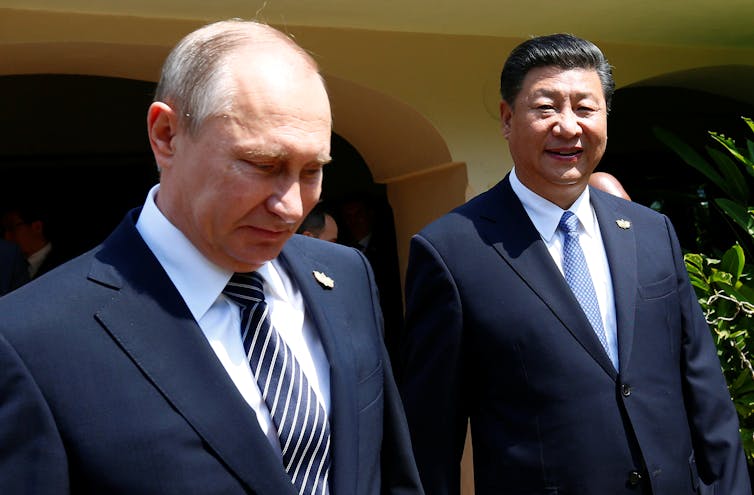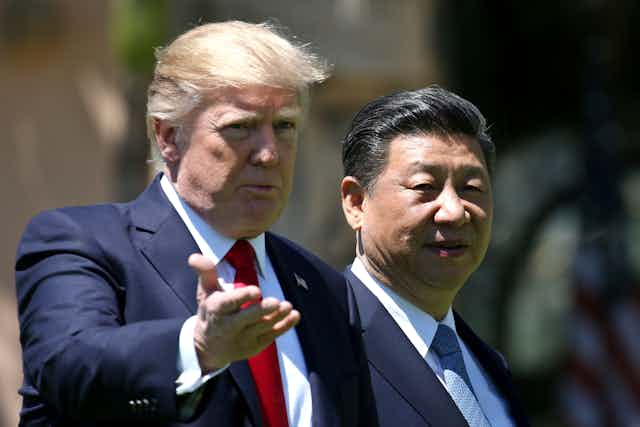Alarm bells are ringing a mere three months into Donald Trump’s presidency. The two global flashpoints, Syria and North Korea, are worrying enough.
More troubling still are America’s relations with Russia and China. These are now mired in angst, uncertainty and mutual suspicion. They underlie the failure to create a viable system of crisis prevention and crisis management.
Global power shift
Trump’s first 100 days as president have dramatically demonstrated this failure. For all the rhetoric about “making America great again”, Trump is rapidly discovering that the US has limited capacity to impose its will on the rest of world.
The trend is visible everywhere – in international trade and finance, diplomacy, and numerous conflicts around the world.
In Russia and China, the US now faces two centres of power that are no longer willing to comply with America’s interests and priorities.
Under Vladimir Putin, Russia has been busy reasserting its influence after years of humiliation following the break-up of the Soviet Union.
Starting from a low base, China has sustained over the last three decades the most remarkable rate of economic growth in modern history. Now it is seeking to exert the political influence commensurate with its new economic status.
America’s relative political decline goes back to its military defeat in Vietnam. Temporarily obscured by the end of the Cold War, it became fully apparent during the Bush and Obama years. But Trump is the first president to have run on a platform openly stating that the US is in decline and promising to reverse the trend.
Militarism not isolationism
In his inauguration speech, studded by more references to “America” than any inauguration speech in US history, Trump vowed:
We will make America strong again. We will make America proud again. We will make America safe again. And we will make America great again.
The nationalist card – the one unifying plank of his otherwise chaotic discourse before and since his election – is meant to strike a chord with the many disenchanted Americans hankering for a “golden age” that has long since passed. Trump now faces the immense challenge of delivering on this pledge despite intractable problems at home and abroad.
On the international stage, he has chosen to rely on showing off America’s unmatched military might. This position is supported by some of the most powerful voices in the US military and political establishment.
Soon after taking office, Trump gave the military expanded authority in the conduct of operations against Islamic State in Syria, Iraq and elsewhere. In support of the Saudi bombing campaign against Houthi forces in Yemen, the US carried out 70 airstrikes in March alone. This is more than twice the number for all of 2016.
In the first two weeks of April, the Trump administration:
announced plans to increase US military spending (already four times greater than China’s and nine times greater than Russia’s) by US$54 billion;
launched 59 Tomahawk missiles against an air force base in Syria, from which a chemical attack on civilians was allegedly conducted;
dropped the most powerful non-nuclear bomb in its arsenal on a cave and tunnel complex in eastern Afghanistan; and
threatened military action against North Korea.
Yet the utility of military power is diminishing. As one centre of power declines and another rises, new faultlines and tensions emerge, and with them new uncertainties. This helps explain why the US finds it so difficult to set a clear policy direction for relations with Russia and China.
The Russia conundrum
In the case of Russia, Trump’s task has been greatly complicated by the findings of the US intelligence community that the Russian government interfered in the 2016 US election.
Hoping to deflect attention from his campaign’s links with Russia, Trump has allowed relations with Russia to continue on their downward slide. Perhaps it was never his intention to reset the US-Russia relationship.
In any case, he is under considerable pressure from his most senior security advisers to act tough with Russia. Almost certainly, he failed to appreciate that his actions and statements on Syria would provoke Putin’s fury.
The end result is clear. In Trump’s words, US relations with Russia have reached “an all-time low”. Not surprisingly, he has now reversed his previous position on NATO, and announced the alliance is “no longer obsolete”.
Russia, for its part, remains unbending in its support of the Assad government in Syria. It has mercilessly denounced the illegality of the US missile attack, and used its veto power to block a UN Security Council resolution condemning Syrian President Bashar al-Assad for his use of chemical weapons.
And now Russia has forced the US to accept a significant watering down of the UN Security Council resolution condemning North Korea’s latest missile launch.

China’s rise
During his election campaign, Trump repeatedly lambasted China for its currency manipulation and threatened to apply tough restrictions on Chinese exports. Before and immediately after his election he flaunted America’s commitment to Taiwan’s security, and challenged China’s military build-up in the South China Sea.
Yet the tone has since changed markedly. Chinese President Xi Jinping’s visit to the US became an occasion to discuss differences on trade and agree to a 100-day plan for reducing the current US trade deficit with China.
At least in public, Xi stuck to his script about the virtues of bilateral co-operation. Trump presented the talks as forming the basis for “an outstanding relationship”.
The North Korea crisis has exposed the limits of US power. Neither increased US economic sanctions nor the threat of military action are likely to force the North Korean regime into submission.
The US needs China’s help to have any chance of reining in North Korea’s nuclear ambitions. China’s response has been to increase pressure on North Korea while issuing a stern warning to both parties.
And so, the relationship remains at best unpredictable. As much as China and the US need each other, the hawks in the Trump administration – and there are many – will not easily abandon their plans to contain China, challenge its claims to sovereignty in the South China Sea, and maintain the US military’s pre-eminence in the region.
However, none of this will halt China’s rise.
What does the future hold?
The months ahead are less than promising. The use and threat of force will do nothing to resolve any of the longstanding conflicts in the Middle East or east Asia.
The projection of military muscle and modernisation of nuclear arsenals are far more likely to produce greater local and regional instability, and heighten the risk of miscalculation from any of the three major centres of power.
Trump and Putin lead countries that hold some 14,000 nuclear weapons, or close to 95% of global stockpiles. These arsenals cast a shadow over US-Russian security, which seems likely to darken with the advent of new technologies and rising levels of mistrust and suspicion.
Pursuing “America First” or “Russia First” policies in conditions of such mutual vulnerability is an exercise in futility.
A more profitable course for these three centres of power is to recognise each other’s legitimate interests, expand the opportunities for economic and diplomatic co-operation, and develop a co-ordinated approach in the management of actual and potential flashpoints.
To bear fruit, such efforts need to have solid foundations – in particular decisive steps to eliminate nuclear weapons, enhance the effectiveness of international law, and strengthen the UN’s capacity for conflict management and peace-building.
Professor Camilleri will explore these issues in depth at a keynote lecture to be delivered at St Michael’s on Collins, Melbourne, on May 9 and 16.

